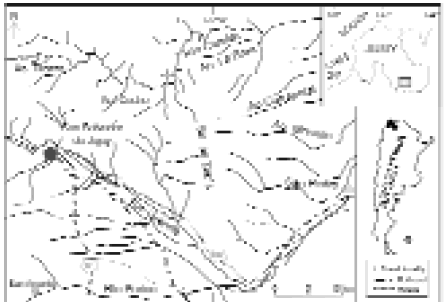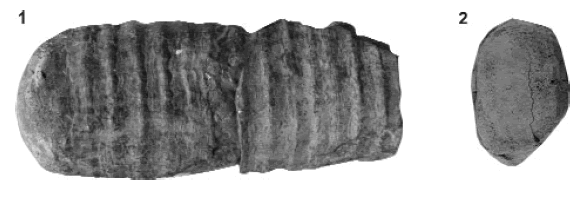Serviços Personalizados
Journal
Artigo
Indicadores
-
 Citado por SciELO
Citado por SciELO
Links relacionados
-
 Similares em
SciELO
Similares em
SciELO
Compartilhar
Ameghiniana
versão On-line ISSN 1851-8044
Ameghiniana v.45 n.4 Buenos Aires dez. 2008
NOTA PALEONTOLÓGICA
The orthocerid Dawsonoceras? (Nautiloidea) from the Lipeón Formation (Silurian, Northwestern Argentina)
Marcela Cichowolski1
1Área de Paleontología, Departamento de Ciencias Geológicas, Universidad de Buenos Aires, Ciudad Universitaria, Pabellón II, Intendente Güiraldes 2160, 1428 Buenos Aires, Argentina. CONICET. mcicho@gl.fcen.uba.ar
Introduction
Turic et al. (1982) erected the name "Rectogloma" zaplensis for a problematic fossil found at Las Capillas River, 20 km northeast of San Salvador de Jujuy city (figure 1). The fossil was collected from beds belonging to the Lipeón Formation (Turner, 1960), on the western flank of the Zapla range (Subandean Ranges). Based on the work of Antelo (1978), the Lipeón Formation was assigned to the Llandovery-Wenlock interval. The fossil was assigned to the problematic genus Rectogloma, described by Tuyl and Berckhemer (1914) for R. problematica, but based on a more complete ornamentation and the presence of sinuous striations, which denotes its better preservation state, they defined a new species: "Rectogloma" zaplensis (Turic et al., 1982). A restudy of the specimen indicates that the fossil is a nautiloid cephalopod that can be assigned with reservation to the genus Dawsonoceras Hyatt, 1884.
Studies of Silurian cephalopods in Argentina are very scarce. Cecioni (1949, in Cecioni, 1953) drew attention to the presence of the genus Dawsonoceras in the Silurian of the Zapla range, in particular D. cf. annulatum (Sowerby, 1816). This author neither illustrated nor described this form. Unidentified nautiloids from the Lipeón Formation at the Zapla range were mentioned by Cuerda and Baldis (1971). In the same report, these authors mentioned Dawsonoceras within a list of trilobite genera from the same stratigraphic unit (based on Cecioni's work). This genus was also recognized with reservation from the Upper Ordovician beds of Puesto Viejo range (in Precordillera) by Aceñolaza (in Aceñolaza and Beressi, 2002).
Geological setting
The Lipeón Formation consists mainly of shales interbedded with fine micaceous sandstones. Red to grey hematitic beds characterize the basal part of the unit (Turic et al., 1982; Ortega et al., 2003). The fossil locality is in the upper part of the Las Capillas River, 20 km northeast of the San Salvador de Jujuy city (figure 1). The Lipeón Formation at this locality has a thickness of about 520 m. The nautiloid was found within the upper third of the unit, in very fine to coarse sandstones, with iron oxide impregnations (Turic et al., 1982).

Figure 1. Location map of the Capillas River locality (from Turic et al., 1982) / mapa de ubicación de la localidad de Río Capillas (de Turic et al., 1982).
The age of the Lipeón Formation is not well-defined (e.g. Baldis et al., 1976; Sánchez, 1989; 1991; Benedetto, 1991; Grahn and Gutiérrez, 2001). Considering the maximum age intervals biostratigraphically dated, this unit could have been deposited between the Llandovery (Aeronian) and the Prídolí (Benedetto et al., 1992).
Systematic paleontology
In the original paper by Turic et al. (1982), authors did not mention any repository for the studied specimen. It is now housed in the Area de Paleontología, Facultad de Ciencias Exactas y Naturales, Universidad de Buenos Aires, under the prefix CPBA.
Order ORTHOCERIDA Kuhn, 1940
Family DAWSONOCERATIDAE Flower, 1962
Genus Dawsonoceras? Hyatt, 1884
Type species. Orthoceras annulatum Sowerby, 1816.
Dawsonoceras? sp.
Figures 2.1-2

Figure 2. 1-2, Dawsonoceras?, Lipeón Formation / Formación Lipeón, CPBA 20387. 1, Lateral view of the body chamber / vista lateral de la cámara habitación; 2, apical view of the body chamber / vista apical de la cámara habitación. Both figures x 1/Ambas figuras x 1.
1982. "Rectogloma" zaplensis; Turic, Ramos and Oliver, p. 4, fig. 3.
Material. The specimen (CPBA 20397) consists of a broken body chamber, of which only the ornamentation pattern of the shell could be seen. The body chamber is preserved as an internal mould cover in part by the remains of the shell wall. The adapical part does not show the siphuncle. This latter condition is probably the reason why Turic et al. (1982) failed to identify the fossil as a cephalopod.
Description. On one side of the specimen, the shell wall is preserved and the pattern of ornamentation can be seen (figure 2.1). The maximum length of the preserved portion of the body chamber is 120 mm, and the maximum adapical width is 42 mm. The fossil is somewhat depressed because of diagenetic compaction. The shell ornamentation consists of regularly spaced annulations (with 15 annulations in the overall length), combined with festooned lirae. There are about five lirae between pairs of annulations. There are also inconspicuous longitudinal ridges that form nodes at the ridges of the annulations (figure 2.1).
Remarks. Based on the revision of the annulated orthoceridan cephalopods of the Baltoscandic Ordovician, Kröger and Isakar (2006) considered the ornamentation of the shell was only of value for generic diagnosis. Since the specimen lacks a phragmocone, there are no diagnostic characters that will allow an assignment of any higher taxonomic group. Until more complete material can be collected, only the pattern of the ornamentation is available for taxonomic determination. Based on the above, and considering the age of the unit, together with the previous citations with regard to cephalopods from this area (Cecioni, 1953), this specimen is preliminarily assigned to the genus Dawsonoceras?. As an additional consideration, the ornament of the studied specimen also resembles that of the pseudorthoceridan genus Gorbyoceras Shimizu and Obata, 1935, which is known from the Upper Ordovician of North America, United Kingdom and Baltoscandia. This alternative identification is less likely for the Lipeón Formation specimen since the age of the unit is considered to be Silurian.
Occurrence. Zapla range, Río Capillas, Lipeón Formation. Silurian.
Discussion
The Lipeón Formation represents a deep marine shelf environment, deposited during a temperate to cold climate (Sánchez, 1989) due to the high paleolatitude where the western margin of Gondwana (specially the Argentine Central Andean Basin) was located by the Silurian (Fortey and Cocks, 2003).
Crick (1993) indicated that after the Late Ordovician, the dispersal potential of the orthoceridans increased and decreased with sea level rises and falls. The early Silurian was generally a period of eustatic rises in sea-level (Benedetto and Sánchez, 1990 and reference herein), favouring the migration of some faunal elements. The orthoceridans may be an example of this migration event. Although Evans (2000) related the presence of orthoceridan genera with high paleolatitude environments, since Dawsonoceras is a cosmopolitan genus, it is not possible to associate it with temperate environments in particular, as it was found in low paleolatitudes as well (e.g. Flower, 1943; Teichert and Glenister, 1952). It was probably a euritopic genus, with a high potential for migration, and capable of inhabiting a variety of paleoenvironments.
Although a taphonomic bias can not be discarded, the low diversity and scarcity of nautiloids in the Lipeón Formation could be related to the high paleolatitude of this part of the western margin of Gondwana during the Silurian, implying a temperate climate, which may not have been optimal for nautiloids (Crick, 1993).
Acknowledgments
I want to thank specially to M.B. Aguirre-Urreta who gave me the original cephalopod material and the original paper of Turic et al. (1982). I thank her also for the suggestions about the original manuscript. I am grateful with B. Kröger (Berlin University) and P.F. Rawson (University College, London) for sending me important bibliographic references, and with Theo Engeser (Freie University, Berlin) for letting me use his Data Retrieval Nautiloidea. I wish to thank also T.M. Sánchez (CIPAL, Córdoba) for the suggestions about original manuscript. I thank D. Evans (Nature England, Peterborough, UK) and Royal Mapes (Ohio University, Athens) for their constructive and helpful reviews of the manuscript.
References
1. Aceñolaza, F.G. and Beresi, M.S. 2002. Ordovician Nautiloids of Argentina. In: F.G. Aceñolaza (ed.), Aspects of the Ordovician System in Argentina. INSUGEO, Serie Correlación Geológica Tucumán 16: 107-120. [ Links ]
2. Antelo, B. 1978. Las formaciones de edad silúrica en el noroeste argentino (provincias de Jujuy y Salta). Revista de la Asociación Geológica Argentina 33: 1-16. [ Links ]
3. Baldis, B., Benedetto, J.L., Blasco, G. and Martell, M.E. 1976. Trilobites Silúricodevónicos de la Sierra de Zapla (Noroeste de Argentina). Ameghiniana 13: 185-225. [ Links ]
4. Benedetto, J.L. 1991. Braquiópodos silúricos de la Formación Lipeón, flanco occidental de la Sierra de Zapla, Provincia de Jujuy, Argentina. Ameghiniana 28: 111-125. [ Links ]
5. Benedetto, J.L. and Sánchez, T.M. 1990. Fauna y edad del estratotipo de la Formación Salar del Rincón (Eopaleozoico, Puna argentina). Ameghiniana 27: 317-326. [ Links ]
6. Benedetto, J.L., Sánchez, T.M. and Brussa, E.D. 1992. Las Cuencas Silúricas de América Latina. In: J.G. Gutiérrez Marco, J. Saavedra and I. Rábano (eds.), Paleozoico Inferior de Ibero- América. Universidad de Extremadura, pp. 119-148. [ Links ]
7. Cecioni, G. 1953. Contribución al conocimiento de los nautiloideos Eo-Paleozoicos argentinos. Parte I: Protocycloceratidae- Cyclostomiceratidae. Boletín del Museo Nacional de Historia Natural de Santiago de Chile 26: 57-109. [ Links ]
8. Crick, R.R. 1993. Biogeography of Early and Middle Paleozoic nautiloid cephalopods: evidence for barriers to dispersal and evolution. Geobios, Memoire Special 15: 91-105. [ Links ]
9. Cuerda, A.J. and Baldis, B.A. 1971. Silúrico-Devónico de la Argentina. Ameghiniana 8: 128-162. [ Links ]
10. Evans, D.H. 2000. A cephalopod fauna from the Middle Ordovician of Saudi Arabia. Palaeontology 43: 573-589. [ Links ]
11. Flower, R.H. 1943. Cephalopods from the Silurian of Arisaig, Nova Scotia. Journal of Paleontology 17: 248-257. [ Links ]
12. Flower, R.H. 1962. Notes on the Michelinoceratida. New Mexico Institute of Mining and Technology, State Bureau of Mines and Mineral Resources, Memoir 10: 21-40. [ Links ]
13. Fortey, R.A. and Cocks, L.R.M. 2003. Palaeontological evidence bearing on global Ordovician-Silurian continental reconstructions. Earth Science Reviews 61: 245-307. [ Links ]
14. Grahn, Y. and Gutiérrez, P.R. 2001. Silurian and Middle Devonian Chitinozoa from the Zapla and Santa Bárbara Ranges, Tarija Basin, northwestern Argentina. Ameghiniana 38: 35-50. [ Links ]
15. Kröger, B. and Isakar, M. 2006. Revision of annulated orthoceridan cephalopods of the Baltoscandic Ordovician. Fossil Record 9: 137-163. [ Links ]
16. Hyatt, A. 1883-84. Genera of fossil cephalopods. Proceedings of the Boston Society of Natural History 22: 273-338. [ Links ]
17. Kuhn, O. 1940. Paläozoologie in Tabellen. 50 p., Jena, Fischer. Ortega, G., Moya, M.C. and Albanesi, G.L. 2003. Zapla Range, Subandean Ranges, Jujuy Province. Ordovician and Silurian of the Cordillera and Sierras Subandinas, NW Argentina. Field Trip Guide. INSUGEO, Miscelánea Tucumán 11: 23-27. [ Links ]
18. Sánchez, T.M. 1989. Bivalvos paleotaxodóntidos de la Formación Lipeón (Silúrico) de la Sierra de Zapla, Provincia de Jujuy, Argentina. Ameghiniana 26: 173-189. [ Links ]
19. Sánchez, T.M. 1991. El género Dualina (Bivalvia, Praecardioida) en la Formación Lipeón (Silúrico), Sierra de Zapla, Provincia de Jujuy, Argentina. Ameghiniana 28: 31-34. [ Links ]
20. Shimizu, S. and Obata, T. 1935. New genera of Gotlandian and Ordovician nautiloids. Shangai Science Institute Journal 2: 1-10. [ Links ]
21. Sowerby, J. 1812-18. The mineral conchology of the Great Britain; or coloured figures and descriptions of those remains of testaceous animals or shells which have been preserved at various times and depths in the Earth. Vol. 2, London, 251 pp. [ Links ]
22. Teichert, C. and Glenister, B.F. 1952. Fossil nautiloid faunas from Australia. Journal of Paleontology 26: 730-752. [ Links ]
23. Turic, M.A., Ramos, V.A. and Oliver Gascón, J. 1982. "Rectogloma" zaplensis (problemática) de la Formación Lipeón, Provincia de Jujuy, Argentina. Revista del Instituto de Ciencias Geológicas 5, Universidad Nacional de Jujuy. [ Links ]
24. Turner, J.C.M. 1960. Estratigrafía de la Sierra de Santa Victoria y adyacencias. Boletín de la Academia Nacional de Ciencias (Córdoba), 41: 262 p. [ Links ]
25. Tuyl, F.M. Van and Berckhemer, F. 1914. A problematic fossil from Catskill Formation. American Journal of Sciences, Series 4: 275-275. [ Links ]
Recibido: 12 de noviembre de 2007.
Aceptado: 12 de septiembre de 2008.














